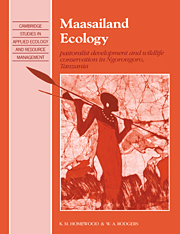Book contents
- Frontmatter
- Contents
- Preface
- 1 Management problems and applied ecology in Ngorongoro Conservation Area
- 2 Ngorongoro Conservation Area
- 3 Maasai of Ngorongoro
- 4 History, politics and perceptions in Ngorongoro
- 5 Management-oriented research in NCA
- 6 Range resources
- 7 Wildlife
- 8 Livestock ecology
- 9 Livestock and wildlife
- 10 Maasai ecology: development, demography and subsistence
- 11 Wildlife conservation and pastoralist development
- 12 Development interventions
- 13 Viewpoint
- References
- Author index
- Subject index
- Map: Ngorongoro Conservation Area, showing the main features and place names used in the text
1 - Management problems and applied ecology in Ngorongoro Conservation Area
Published online by Cambridge University Press: 08 February 2010
- Frontmatter
- Contents
- Preface
- 1 Management problems and applied ecology in Ngorongoro Conservation Area
- 2 Ngorongoro Conservation Area
- 3 Maasai of Ngorongoro
- 4 History, politics and perceptions in Ngorongoro
- 5 Management-oriented research in NCA
- 6 Range resources
- 7 Wildlife
- 8 Livestock ecology
- 9 Livestock and wildlife
- 10 Maasai ecology: development, demography and subsistence
- 11 Wildlife conservation and pastoralist development
- 12 Development interventions
- 13 Viewpoint
- References
- Author index
- Subject index
- Map: Ngorongoro Conservation Area, showing the main features and place names used in the text
Summary
The Authority is charged with the duty of conserving and developing the natural and human resources of the Ngorongoro Conservation Area
Ngorongoro Conservation Area Ordinance, Cap. 413.This book discusses the ecology and management of Ngorongoro Conservation Area (NCA) in northern Tanzania. NCA is internationally renowned as a conservation area for its scenic beauty, its spectacular wildlife, and its important archaeological and paleontological remains. It is also outstanding for its pioneering joint land use policy, which is dominated by conservation aims but at the same time maintains a large population of Maasai pastoralists living from traditional cattle and small stock husbandry. NCA does, however, illustrate a number of problems, ranging from the biological to the political, that are common to other semi-arid rangelands. In particular, joint land use inevitably means conflict between different interest groups. Despite these problems NCA has worked for thirty years and is still seen as a pilot model for multiple land use management in the semi-arid rangelands of East African Maasailand, and to some extent for the savannas of sub-Saharan Africa.
The central management issue in NCA is the conflict between conservation and pastoralist interests that has surfaced in many ways throughout Maasailand and elsewhere in Africa. In biological terms the conflict centres on the relative demands and impacts of livestock, wildlife and people on the natural resources. Maasai and conservationists see livestock and wild ungulates as competing for grazing, with important consequences for population dynamics and productivity of wild and domestic herds.
- Type
- Chapter
- Information
- Maasailand EcologyPastoralist Development and Wildlife Conservation in Ngorongoro, Tanzania, pp. 1 - 7Publisher: Cambridge University PressPrint publication year: 1991
- 1
- Cited by

